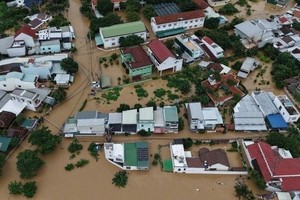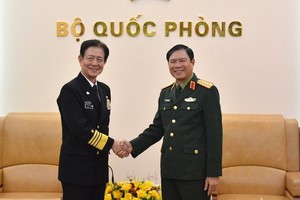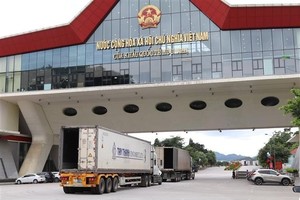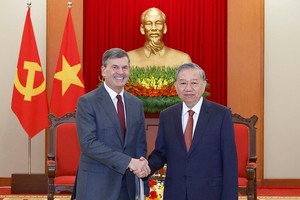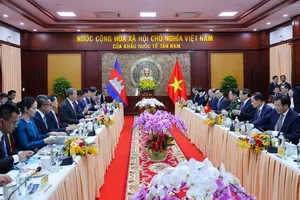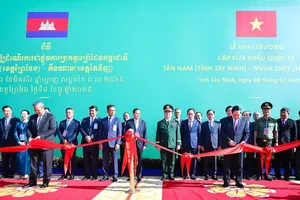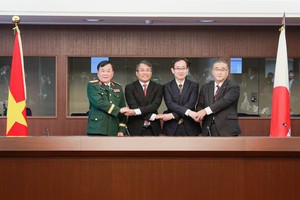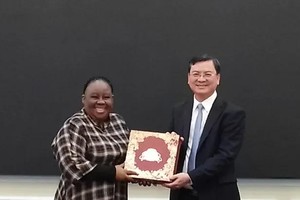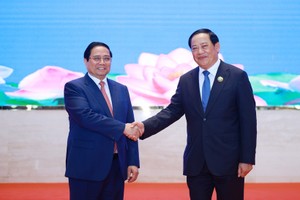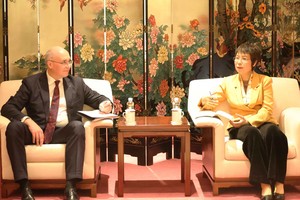
It announced the Hwasong-15, an upgrade of the Hwasong-14 intercontinental ballistic missile (ICBM), can carry a super-sized nuclear warhead, a feat the North's leader described as the final touches on the country's nuclear weapons development.
"It is the most powerful ICBM which meets the goal of the completion of the rocket weaponry system development set by the DPRK," the Korean Central News Agency (KCNA) said in its English-language report, using the acronym for the country's official name, the Democratic People's Republic of Korea.
The announcement came hours after the firing of a projectile from the outskirts of Pyongyang was detected.
During its 53-minute flight, it traveled 950 kilometers at an apogee of 4,475 km to splash into the East Sea, an assertion confirmed by the defense authorities of South Korea, the United States and Japan.
The data suggest that the North has succeeded in extending the range of its ICBM enough to threaten the Eastern U.S., while it remains a question whether it has mastered atmospheric re-entry and warhead miniaturization technologies for a reliable ICBM.
The provocation threw cold water on hopes of a shift to the dialogue phase amid a pause in the North's missile launches for 2 1/2 months.
It showed that the Kim regime remains eager to be recognized as a nuclear state, not interested in denuclearization talks for now.
The missile was apparently fired at a lofted angle. If done at a standard one, it could have gone far over 10,000 km, given its maximum altitude, experts said.
"If these numbers are correct, then if flown on a standard trajectory rather than this lofted trajectory, this missile would have a range of more than 13,000 kilometers (km) (8,100 miles)," David Wright, a co-director of the Union of Concerned Scientists, wrote on his organization's blog.
U.S. Secretary of Defense James Mattis took note of the height as well.
He said his administration would not "sit and watch" the North's belligerence.
Moon later had 20-minute phone talks with U.S. President Donald Trump, in which they "underscored the grave threat that North Korea's latest provocation poses not only to the United States and the Republic of Korea but to the entire world."
Moon told Trump that the North's missile technology is deemed to have improved. They agreed to keep putting "pressure and sanctions" on the regime in close coordination with each other, said Moon's office Cheong Wa Dae.
South Korea's Foreign Minister Kang Kyung-wha and her American counterpart Rex Tillerson talked about the issue as well by phone and vowed to make all diplomatic efforts for the denuclearization of Korea.
Speaking in New York, U.S. Vice President Mike Pence reaffirmed that "all options" are on the table, with his administration considering "additional measures."
He warned the North not to test the resolve of Trump and U.S. military power.
In a separate statement, Seoul's foreign ministry urged Pyongyang to halt such "reckless" provocations that only escalate tensions on the peninsula and deepen the North's isolation and economic hardship.
The U.N. Security Council will soon hold an emergency session in New York to discuss how to punish the North for the launch, which constituted a clear violation of several resolutions.
The South's military described the North's move as a "serious threat" to Seoul and its alliance with Washington.
The allies are "maintaining the ability and posture to strike the origin of provocation and command and support facilities with precision anytime, on the ground, at sea and in the air," the JCS said.
"It went higher, frankly, than any previous shot they've taken," he told reporters at the White House. "It's a research and development effort on their part to continue building ballistic missiles that can threaten everywhere in the world."
South Korean President Moon Jae-in strongly denounced the North for its "military brinkmanship."
Once the North completes its ICBM development, he warned, the security situation will become exacerbated to an "uncontrollable" level.
South Korea and the U.S. said they need more time and materials to see if the North has actually reached the point.
"Our government has emphasized repeatedly on major occasions that we will offer a bright future if (North Korea) comes to the dialogue table. Despite our sincere efforts and appeals, it fired a ballistic missile today," Moon said, presiding over a National Security Council meeting.
In a show of force, the South's armed forces conducted a live-fire missile exercise near the Northern Limit Line in the East Sea, minutes after the North's missile firing.
It involved an Army missile unit, a Navy Aegis ship and an Air Force KF-16 fighter jet, each firing a missile at a simulated target set in consideration of the distance to the site where the North launched the missile.
The North's missile launch marked its first since Sept. 15, when it fired an intermediate-range ballistic missile (IRBM) over Japan. That projectile flew about 3,700 km at a maximum altitude of 770 km.
The newest launch is the 11th missile provocation by the communist nation since the South's president took office in May with the stated policy goal of improving inter-Korean ties and bringing lasting peace to the peninsula.
The North previously launched an ICBM on July 4 and another on July 28.
On the Kim Jong-un regime's intentions, the JCS official said it seems to be protesting against diplomatic and economic pressure from the world, including the U.S. decision to put Pyongyang back on the list of state sponsors of terrorism.
Kim may be also seeking to strengthen the unity of his regime, which is facing economic troubles and potential political unrest from the purge of some senior officials and a local soldier's defection to the South via the truce village of Panmunjom, he said.
SOURCE FROM THE YONHAP.